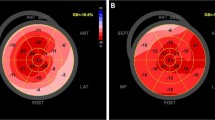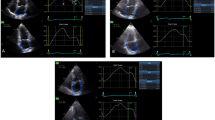Abstract
Abnormal P-wave characteristics were reportedly associated with left ventricular interstitial fibrosis as defined by cardiac magnetic resonance images. The objective of this study is to investigate the utility of P-wave characteristics to predict atrial fibrillation (AF) recurrence and the recovery of left ventricular systolic dysfunction (LVSD) after catheter ablation (CA) for AF. Two hundred and five AF patients (109 paroxysmal and 96 persistent) who underwent CA were enrolled. We measured maximum P-wave duration (max PWD) and P-wave terminal force in lead V1 (PTFV1) calculated as a product of P-wave terminal amplitude (PTaV1) and duration (PTdV1) in lead V1 during sinus rhythm. AF recurrence was noted in 50 patients at 12 months after CA. Patients with AF recurrence had a higher prevalence of persistent AF, a larger left atrial volume, and a longer max PWD than those without. We divided the patients into 2 groups: 156 patients with left ventricular ejection fraction (LVEF) > 45% and 49 patients with LVEF ≤ 45% (Low-EF group). In Low-EF group, tachycardia-induced cardiomyopathy (TIC) was defined as improvement in LVEF ≥ 15% or LVEF ≥ 50% at 5 months after CA. TIC and non-TIC groups consisted of 37 and 12 patients, respectively. Max PWD, PTFV1, PTdV1, and PTaV1 were significantly greater in non-TIC-group than in TIC-group. PTFV1 had the highest diagnostic accuracy to discriminate between TIC and no-TIC-groups; cut-off value for PTFV1 was determined as 56.7 mV ms (area under the ROC curve = 0.80; 75% sensitivity; and 76% specificity). Max PWD was a useful predictor of AF recurrence and the complete recovery of LVSD after CA. PTFV1 had the highest diagnostic accuracy to discriminate between TIC and no-TIC-groups.



Similar content being viewed by others
References
Nerheim P, Birger-Botkin S, Piracha L, Olshansky B (2004) Heart failure and sudden death in patients with tachycardia-induced cardiomyopathy and recurrent tachycardia. Circulation 110:247–252
Gopinathannair R, Etheridge SP, Marchlinski FE, Spinale FG, Lakkireddy D, Olshansky B (2015) Arrhythmia-induced cardiomyopathies: mechanisms, recognition, and management. J Am Coll Cardiol 66:1714–1728
Sairaku A, Nakano Y, Oda N, Uchimura Y, Tokuyama T, Kawazoe H, Fujiwara M, Watanabe Y, Matsumura H, Kihara Y (2014) Incomplete cure of tachycardia-induced cardiomyopathy secondary to rapid atrial fibrillation by heart rate control without sinus conversion. J Cardiovasc Electrophysiol 25:1037–1043
Nedios S, Sommer P, Dagres N, Kosiuk J, Arya A, Richter S, Gaspar T, Kanagkinis N, Dinov B, Piorkowski C, Bollmann A, Hindricks G, Rolf S (2014) Long-term follow-up after atrial fibrillation ablation in patients with impaired left ventricular systolic function: the importance of rhythm and rate control. Heart Rhythm 11:344–351
Ling LH, Kalman JM, Ellims AH, Iles LM, Medi C, Sherratt C, Kaye DM, Hare JL, Kistler PM, Taylor AJ (2013) Diffuse ventricular fibrosis is a late outcome of tachycardia-mediated cardiomyopathy after successful ablation. Circ Arrhythm Electrophysiol 6:697–704
Ling LH, Taylor AJ, Ellims AH, Iles LM, McLellan AJ, Lee G, Teh A, Medi C, Kaye DM, Kalman JM, Kistler PM (2013) Sinus rhythm restores ventricular function in patients with cardiomyopathy and no late gadolinium enhancement on cardiac magnetic resonance imaging who undergo catheter ablation for atrial fibrillation. Heart Rhythm 10:1334–1339
Hasdemir C, Yusei A, Camli D, Kartal Y, Simsk E, Musayerv O, Isayev E, Aydin M, Can LH (2012) Late gadolinium enhancement CMR in patients with tachycardia-induced cardiomyopathy after successful ablation. Pacing Clin Electrophysiol 35:465–470
Ishida K, Hayashi H, Miyamoto A, Sugimoto Y, Ito M, Murakami Y, Horie M (2010) P wave and the development of atrial fibrillation. Heart Rhythm 7:289–294
Magnani JW, Zhu L, Lopez F, Pencina MJ, Agarwal SK, Soliman EZ, Benjamin EJ, Alonso A (2015) P-wave indices and atrial fibrillation: cross-cohort assessments from the Framingham Heart Study (FHS) and Atherosclerosis Risk in Communities (ARIC) study. Am Heart J 169:53–61
Kamel H, Hunter M, Moon YP, Yaghi S, Cheung K, Di Tullio MR, Okin PM, Sacco RL, Soliman EZ, Elkind MS (2015) Electrocardiographic left atrial abnormality and risk of stroke: Northern Manhattan Study. Stroke 46:3208–3212
Pirinen J, Putaala J, Aarnio K, Aro AL, Sinisalo J, Kaste M, Haapaniemi E, Tatlisumak T, Lehto M (2016) Are 12-lead ECG findings associated with the risk of cardiovascular events after ischemic stroke in young adults? Ann Med 48:532–540
Liu G, Tamura A, Torigoe K, Kawano Y, Shinozaki K, Kotoku M, Kadota J (2013) Abnormal P-wave terminal force in lead V1 is associated with cardiac death or hospitalization for heart failure in prior myocardial infarction. Heart Vessels 28:690–695
Tiffany Win T, Ambale Venkatesh B, Volpe GJ, Mewton N, Rizzi P, Sharma RK, Strauss DG, Lima JA, Tereshchenko LG (2015) Associations of electrocardiographic P-wave characteristics with left atrial function, and diffuse left ventricular fibrosis defined by cardiac magnetic resonance: the PRIMERI Study. Heart Rhythm 12:155–162
January CT, Wann LS, Alpert JS, Calkins H, Cigarroa JE, Cleveland JC Jr, Conti JB, Ellinor PT, Ezekowitz MD, Field ME, Murray KT, Sacco RL, Stevenson WG, Tchou PJ, Tracy CM, Yancy CW, ACC/AHA Task Force Members (2014) 2014 AHA/ACC/HRS guideline for the management of patients with atrial fibrillation: executive summary: a report of the American College of Cardiology/American Heart Association Task Force on practice guidelines and the Heart Rhythm Society. Circulation 130:2071–2104
Wang YS, Chen GY, Li XH, Zhou X, Li YG (2017) Prolonged P-wave duration is associated with atrial fibrillation recurrence after radiofrequency catheter ablation: a systematic review and meta-analysis. Int J Cardiol 227:355–359
Njoku A, Kannabhiran M, Arora R, Reddy P, Gopinathannair R, Lakkireddy D, Dominic P (2018) Left atrial volume predicts atrial fibrillation recurrence after radiofrequency ablation: a meta-analysis. Europace 20:33–42
Ishii S, Inomata T, Ikeda Y, Nabeta T, Iwamoto M, Watanabe I, Naruke T, Shinagawa H, Koitabashi T, Nishii M, Takeuchi I, Izumi T (2014) Clinical significance of heart rate during acute decompensated heart failure to predict left ventricular reverse remodeling and prognosis in response to therapies in nonischemic dilated cardiomyopathy. Heart Vessels 29:88–96
Morris JJ, Estes EH, WhalenRE Thompson HK, Mcintosh HD (1964) P-wave analysis in valvular heart disease. Circulation 29:242–252
Mueller KAL, Heinzmann D, Klingel K, Fallier-Becker P, Kandolf R, Kilias A, Walker-Allgaier B, Borst O, Kumbrink J, Kirchner T, Langer H, Geisler T, Schreieck J, Gramlich M, Gawaz M, Seizer P (2017) Histopathological and immunological characteristics of tachycardia-induced cardiomyopathy. J Am Coll Cardiol 69:2160–2172
Gulati A, Ismail TF, Jabbour A, Ismail NA, Morarji K, Ali A, Raza S, Khwaja J, Brown TD, Liodakis E, Baksi AJ, Shakur R, Guha K, Roughton M, Wage R, Cook SA, Alpendurada F, Assomull RG, Mohiaddin RH, Cowie MR, Pennell DJ, Prasad SK (2013) Clinical utility and prognostic value of left atrial volume assessment by cardiovascular magnetic resonance in non-ischaemic dilated cardiomyopathy. Eur J Heart Fail 15:660–670
Kim SJ, Choisy SC, Barman P, Zhang H, Hancox JC, Jones SA, James AF (2011) Atrial remodeling and the substrate for atrial fibrillation in rat hearts with elevated afterload. Circ Arrhythm Electrophysiol 4:761–769
Hanna N, Cardin S, Leung TK, Nattel S (2004) Differences in atrial versus ventricular remodeling in dogs with ventricular tachypacing-induced congestive heart failure. Cardiovasc Res 63:236–244
Rubler S, Shah NN, Moallem A (1976) Comparison of left atrial size and pulmonary capillary pressure with P wave of electrocardiogram. Am Heart J 92:73–78
Marrouche NF, Brachmann J, Andresen D, Siebels J, Boersma L, Jordaens L, Merkely B, Pokushalov E, Sanders P, Proff J, Schunkert H, Christ H, Vogt J, Bänsch D, Investigators CASTLE-AF (2018) Catheter ablation for atrial fibrillation with heart failure. N Engl J Med 378:417–427
Author information
Authors and Affiliations
Corresponding author
Ethics declarations
Conflict of interest
The authors declare that they have no competing interests.
Rights and permissions
About this article
Cite this article
Doi, A., Takagi, M., Katayama, H. et al. Diagnostic value of electrocardiographic P-wave characteristics in atrial fibrillation recurrence and tachycardia-induced cardiomyopathy after catheter ablation. Heart Vessels 33, 1381–1389 (2018). https://doi.org/10.1007/s00380-018-1179-4
Received:
Accepted:
Published:
Issue Date:
DOI: https://doi.org/10.1007/s00380-018-1179-4




